




placename:-
The area is labelled:- "Gilsland Spa"
with detail labels - 'Chalybeate Spa' at about NY63306790 roughly corresponding to a spa on the modern map; Sulphurous Spa about NY63556782; Baths about NY63446776; and 'Bookstall' about 63546782.
placename:- Gilsland Spaw
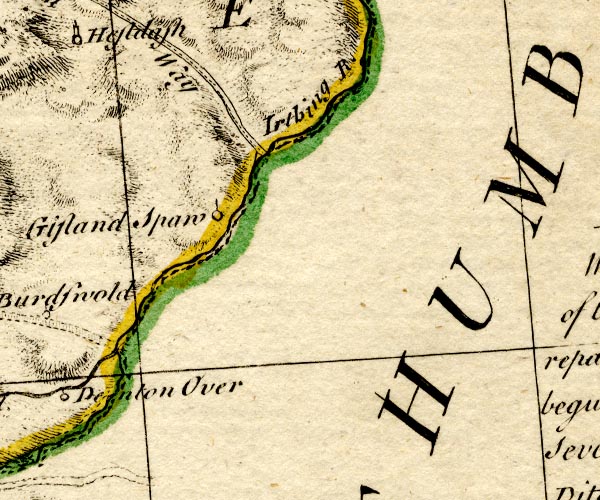
BO18NY76.jpg
"Gilsland Spaw"
circle and line
item:- Armitt Library : 2008.14.10
Image © see bottom of page
placename:- Gilsland Spaw
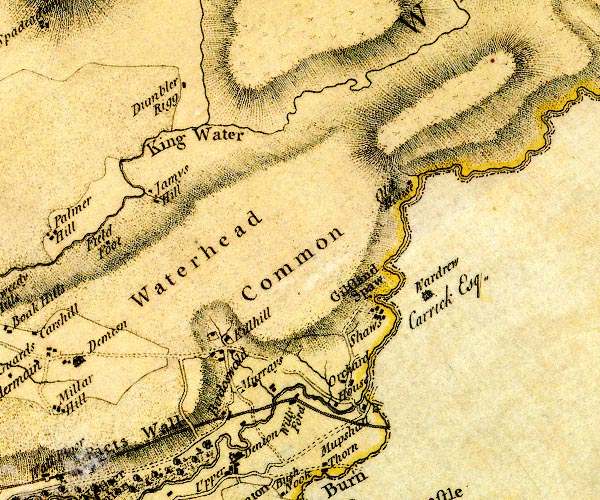
D4NY66NW.jpg
"Gilsland Spaw"
a block
item:- Carlisle Library : Map 2
Image © Carlisle Library
placename:- Gilsland Spa
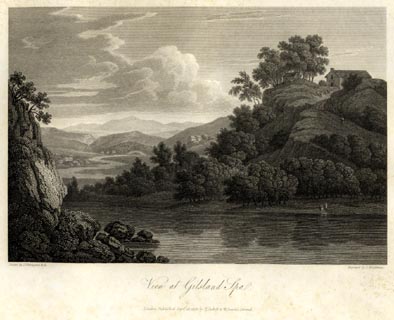 click to enlarge
click to enlargeFA0428.jpg
printed, bottom left, right, centre "Drawn by J. Farington R.A. / Engraved by S. Middiman. / View at Gilsland Spa. / London Published Septr. 15, 1815, by T. Cadell &W. Davies, Strand."
Descriptive text:- "VIEW AT GILSLAND SPA."
"THE sulphureted Spa at Gilsland, is situated in a romantic woody glen, on the western bank of the river Irthing, and on the confines of Northumberland, about 18 miles from Carlisle. Gilsland Spa has been a place of fashionable resort for upwards of seventy years, its waters having been in much repute, particularly for the cure of cutaneous disorders. There are three hotels here for the accommodation of company; Wardrew-house, on the Northumberland side of the Irthing, and the Shaws and the Orchard-house on the Cumberland side; besides which there are two neat lodging houses. The accommodation is good and reasonable, and the visitor will find amusement in making excursions in the neighbourhood, which affords interesting matter of research to the naturalist and the antiquary. There are some Chalybeate springs near the sulphureted Spa; one of these was discovered in 1811. The scenery of Gilsland forms a strong contrast to that of the wild moors by which it is encircled. "Upon the top of the bank at the Shaws hotel, there is a broad Terrace walk, from which there is a pleasing view towards the opposite bank of the Irthing, including Wardrew house. At the upper end of this walk, immediately above the sulphureted Spa, the whole dell below, opens at once to the view, unfolding grand scenes of picturesque beauty, to which art has judiciously contributed her assistance. Walks on each side the river, are seen at several places through the variegated woods, having benches at proper distances. Upon leaving the Shaws hotel for the sulphureted Spa, we descend by a steep gravel walk to the river, where the eye is charmed by a finely-wooded amphitheatre of stratified rocks, which give an impressive air of grandeur to this favoured spot."[star]"
"[star] Treatise of the Gilsland Waters, by W. R. Clanny, MD.D 1816."
item:- Armitt Library : A6666.28
Image © see bottom of page
placename:- Gilsland Spa
placename:- Holy Well
placename:- Wardrew Spa
 goto source
goto sourcePage 115:- "..."
"GILSLAND SPA"
"Is a place of great resort, and in point of salubrity and natural beauty, it is far superior to many spas of modern celebrity in the northern part of the island."
"From the Railway Station at Rose Hill, a good carriage-road leads up in a gradual ascending sweep, passing a beautiful mansion called the Orchard House, until it reaches the Shaws Hotel, which stands upon an eminence skirted with fine wood. This hotel has recently been thoroughly repaired, enlarged, and remodelled, and now presents good accommodation to family parties and visitors, whether for health or pleasure. ..."
"Behind the hotel is a field with walks and seats, exhibiting various windings of the Irthing, in its course from the wild fells in the waste. This field covers the mass of rock strata, at the foot of which,"
 goto source
goto sourcePage 116:- "and on the margin of the river, the celebrated spa issues into day. The strata below the surface mould are said to be disposed in the following order:- First, a course of stratified sandstone, then bituminous shale, which includes a stratum of aluminous schistus, and next porphyry slate, beneath which the sulphurated water issues through a leaden tube, enclosed in a small stone fountain, at the rate of two gallons and a half per minute. The whole height of the precipice is about 90 feet. The strata are intersected by two veins, one upon each side of the sulphurated water, which commencing at the surface, approximate pretty uniformly until they reach the river, at which place they are about 150 yards distant. These veins are composed of calcareous spar and iron pyrites, and contain the above-mentioned strata between them."
"This water is remarkably transparent; when poured from one tumbler into another, it sparkles very briskly. To most palates the taste is very agreeable, being somewhat accidulous, and it has generally been found to sit lightly on the stomach. The smell is so strongly impregnated with sulphur as to extend to the distance of several yards. It was originally known by the name of the Holy Well, also by that of Wardrew Spa, the latter name being taken from the tenement and farm on the Northumberland side of the water, and which appears to have been, at one time, the only original place of entertainment. The present mansion was erected in 1752, and is a large and elegantly-"
 goto source
goto sourcePage 117:- "[elegantly-]finished place, though now in a state of great delapidation."
"These waters may be employed either externally or internally in a diversity of diseases, with great success. There are hot and cold baths fitted up in the immediate contiguity of the spring, and also at the hotel. In drinking the water no other precaution or preparation seems necessary than that of commencing with moderation. Time and experience have proved its virtues; and during the last century up to the present time, it has been used both externally and internally with amazing success."
"The walk from the hotel down to the spa is short, dry in all weathers, and rather too steep, and will be found inconveniently so on the return by the invalid, although seats are placed at suitable distances, to render the fatigue as light as possible. At the bottom of the hill the path is continued along the water's brink, on a paved terrace to the spa. On the right, adjoining the river, are some plain buildings for the baths, and immediately across the water, a number of large stepping-stones enable you to visit the opposite banks, which are finely wooded, and offer several interesting views from various open points."
placename:- Gilsland Spa
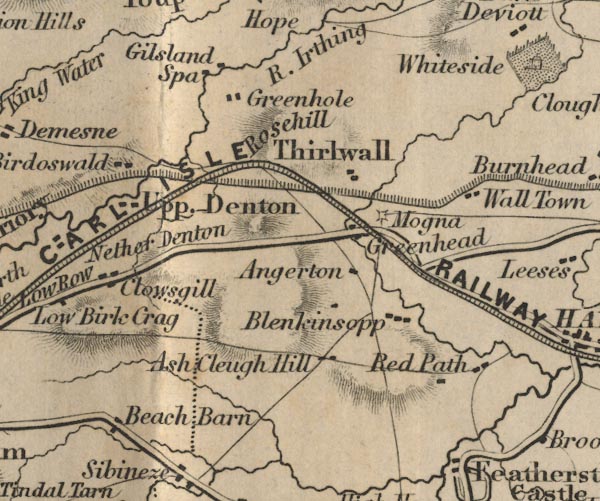
FD02NY66.jpg
"Gilsland Spa"
item:- JandMN : 100.1
Image © see bottom of page
| quote | ||
| Sulphuretted hydrogen gas | 17.0 cub. ins. | |
| Carbonic acid gas | 6.2 | |
| Total gaseous fluid | 23.2 cub. ins | |
| Common salt | 20.05864 grains | |
| Carbonate of soda | 4.50296 | |
| Carbonate of lime | 1.462 | |
| Silica | 1.1696 | |
| quote | ||
| Proto-carbonate of iron | 0.66 grains | |
| Carbonate of lime | 2.39 | |
| Carbonate of magnesia | 0.73 | |
| Sulphate of lime | 0.41 | |
| Sulphate of potash | 0.11 | |
| Sulphate of soda | 2.62 | |
| Chloride of sodium | 5.07 | |
| Carbonate of soda | 21.49 | |
| Sulphide of sodium | 1.78 | |
| Organic matter | 1.92 | |
| Silica | 0.81 | |
| 37.99 grains | ||
| quote | ||
| Combined carbonic acid gas | 22.56 cub. ins. | |
| Free carbonic acid | 0.44 | |
| 23.09 cub. ins. | ||
| quote | ||
| Oxygen gas in one gallon | 2.2 cub. ins. | |
| Nitrogen gas | 5.8 | |
| Dulphuretted hydrogen | 21.0 | |
| quote | ||
| COMPOSITION OF ONE GALLON | ||
| Proto-carbonate of iron | 1.16 grains | |
| Carbonate of lime | 5.89 | |
| Sulphate of potash | 1.41 | |
| Carbonate of magnesia L 1.82 | ||
| Sulphate of soda | 0.94 | |
| Carbonate of soda | 1.24 | |
| Chloride of sodiium | 0.69 | |
| Silica | 1.28 | |
| Organic matter | 2.92 | |
| 17.35 | ||
| quote | ||
| Combined carbonic acid gas | 9.57 cub. ins. | |
| Free carbonic acid gas | 2.63 | |
| Total in one gallon | 12.20 cub. ins. | |
| Oxygen gas in one gallon | 1.6 cub. ins. | |
| Nitrogen gas | 5.7 | |
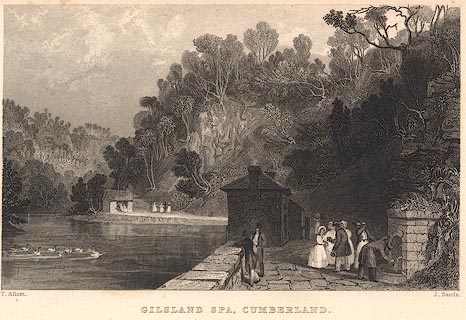 click to enlarge
click to enlargeR249.jpg
"Gilsland Spa, Cumberland"
item:- JandMN : 96.16
Image © see bottom of page
placename:- Gilsland Spa
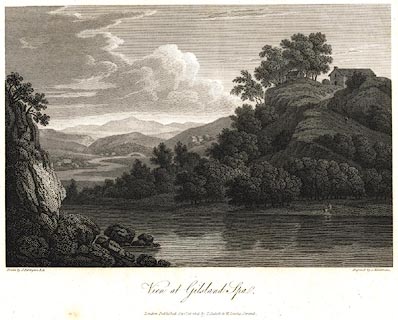 click to enlarge
click to enlargePR0509.jpg
Plate 27 in The Lakes of Lancashire, Westmorland, and Cumberland.
printed at bottom, left, right, centre:- "Drawn by J. Farington R.A. / Engraved by S. Middiman. / View at Gilsland Spa. / London Published Septr. 15, 1815, by T. Cadell &W. Davies, Strand."
item:- Dove Cottage : 2008.107.458
Image © see bottom of page
